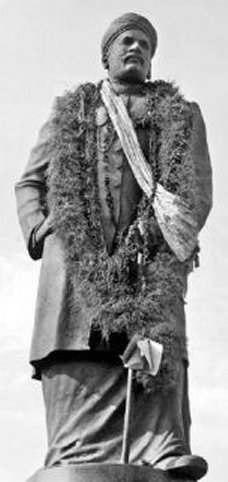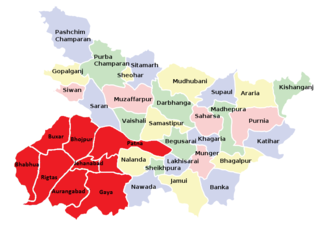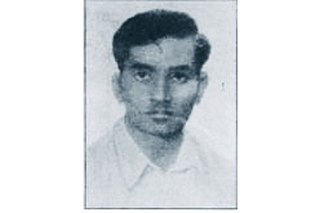
Mahatma Ayyankali was an Indian politician, prominent social reformer, educator, economist, lawmaker, and revolutionary leader. He worked for the advancement of the oppressed people in the princely state of Travancore. His struggle resulted in many changes that improved the socio-political structure of Kerala. His determined and relentless efforts changed the lives of Dalits. He is known as the King of Pulaya.

The Ranvir Sena is a militia functioning as a landlord group, mainly based in the state of Bihar, India. The group was formed by Bhumihar Brahmin landlords under the leadership of Brahmeshwar Mukhiya in 1994, with the aim to counter the influence of various left-wing militants, Naxalite groups and the Communist Party of India (Marxist–Leninist) Liberation (CPI-ML) in central Bihar. The Ranvir Sena has been connected to a number of massacres including the massacre at Laxmanpur Bathe. It has, on several occasions, been accused of human rights abuses. The Bihar state government banned the Ranvir Sena in July 1995, but the group continue to remain active. The group has frequently publicly claimed responsibility for its crimes with impunity.
Kushwaha is a community of the Indo-Gangetic Plain that has traditionally been involved in agriculture, including beekeeping. The term has been used to represent different sub-castes of the Kachhis, Kachhvahas, Koeris and Muraos. The Kushwaha had worshipped Shiva and Shakta, but beginning in the 20th century, they claim descent from the Suryavansh (Solar) dynasty via Kusha, one of the twin sons of Rama and Sita. At present, it is a broad community formed by coming together of several caste groups with similar occupational backgrounds and socio-economic status, who, over the time, started inter-marrying among themselves and created all India caste network for caste solidarity. The communities which merged into this caste cluster includes Kachhi, Kachhwaha, Kushwaha, Mali, Marrar, Saini, Sonkar, Murai, Shakya, Maurya, Koeri and Panara. In 1921, historian Ganga Prasad Gupta published a book claiming that the Kushwaha were of Kshatriya status or Varna.

Bhumihar, also locally called Bhuinhar and Babhan, is a Hindu caste mainly found in Bihar, the Purvanchal region of Uttar Pradesh, Jharkhand, the Bundelkhand region of Madhya Pradesh, and Nepal.
The politics of Bihar, an eastern state of India, is dominated by regional political parties. As of 2021, the main political groups are Rashtriya Janata Dal (RJD), Bharatiya Janata Party (BJP), Janata Dal (United) (JDU), Indian National Congress (INC), Left Front, Lok Janshakti Party (LJP), Hindustani Awam Morcha (HAM). There are also some smaller regional parties, including Samata Party, Hindustani Awam Morcha, Rashtriya Jan Jan Party, Rashtriya Lok Janata Dal, Jan Adhikar Party and Vikassheel Insaan Party, Lok Janshakti Party and Rashtriya Lok Janshakti Party, which play a vital role in politics of state. As of 2024, Bihar is currently ruled by NDA, after JDU break out from Mahagatbandhan coalition and returned to NDA fold.
The Koeri, also referred to as Kushwaha and more recently self-described as Maurya in several parts of northern India are an Indian non-elite caste, found largely in Bihar and Uttar Pradesh, whose traditional occupation was agriculture. According to Arvind Narayan Das they were horticulturists rather than agriculturists. They are also recorded as performing the work of Mahajan in credit market of rural parts of Bihar and Bengal in 1880s. Koeris have attempted Sanskritisation— as part of social resurgence. During the British rule in India, Koeris were described as "agriculturalists" along with Kurmis and other cultivating castes. They are described as a dominant caste in various opinions.
Poykayil Sree Kumara Gurudevan, known as Poykayil Appachan or Poykayil Yohannan, was a spiritual leader, poet, Dalit emancipator, renaissance leader and the founder of the socio-religious movement Prathyaksha Raksha Daiva Sabha.
The 1996 Bathani Tola massacre was an incident of caste-related violence in which an upper-caste militia killed 21 Dalits, including women and children, in the Bhojpur district in Indian state of Bihar on 11 July 1996. The attacks were allegedly by members of the Ranvir Sena, in response to Dalit labourers' demand for wage increase.
Bara massacre was a caste based carnage that took place in 1992 in Bihar. At midnight on 12–13 February 1992, the Maoist Communist Centre of India killed 40 Bhumihars at Bara Village in Gaya district of Bihar, India. The MCC's armed group brought the 35 men of Bara village to the bank of a nearby canal, tied their hands and slit their throats. As many as 36 people were accused of the crime, but charges were framed against only 13. The police failed to arrest the others, who had defied their summons.
The Paswan, also known as Dusadh, are a Dalit community from eastern India. They are found mainly in the states of Bihar, Uttar Pradesh and Jharkhand. The Urdu word Paswan means bodyguard or "one who defends". The origin of the word, per the belief of the community, lies in their participation in the battle against Siraj-ud-daulah, the Nawab of Bengal at the behest of British East India Company, after which they were rewarded with the post of Chowkidars and lathi wielding tax collector for the Zamindars. They follow certain rituals such as walking on fire to assert their valour.
Ramratan Janorkar was a dalit leader and former mayor of Nagpur city.
Rajputs in Bihar are members of the Rajput community living in the eastern Indian state of Bihar. They traditionally formed part of the feudal elite in Bihari society. Rajputs were pressed with the Zamindari abolition and Bhoodan movement in post-independence India; along with other Forward Castes, they lost their significant position in Bihar's agrarian society, leading to the rise of Other Backward Classes (OBCs).

Jagdish Mahto was an Indian communist activist. He was a naxal leader who led the 1970 Bhojpur uprising in the landlord-dominated Bhojpur region of Bihar. He was a member of the Communist Party of India (Marxist–Leninist), an organisation which was leading the Naxalite insurgency in Bihar. He also fought against the upper-caste landlords for the cause of lower-caste people. Mahto, also called Master Saheb, was a member of the Bihar State Committee of CPI(M–L) and one of the founding leaders of the party in Bhojpur.
The Lorik Sena was a caste-based private army of Yadav (Ahir) Community with its headquarters in Jaitipur village of the Nalanda district of Bihar. The majority of its members hailed from the Yadav community, who were organised by its founder Baiju Yadav, to launch an armed struggle against Maoists and other communities such as Bhumihars, Rajputs. It was another group after Samajwadi Shoshit Sena which recruited primarily from the Ahir-Yadav community. According to local folktales, Lorik was a legendary hero of the Yadav raiyyats (peasants) who waged a struggle against the tyranny of repressive kings and the feudal lords and held the Yadav dignity intact. These Senas were based primarily on the name of such community figures, either realistic or mythical who were venerated by whole community. While the Rajputs chose the 19th century figure, King Kunwar Singh's name for their private army, the Yadav community found their mythical hero as suitable for the same.
The Backward Caste movement in Bihar can be traced back to the formation of Triveni Sangh, a caste coalition and political party, in the 1930s, which was revived after the introduction of land reforms in the 1950s aimed at removing intermediaries from agrarian society. But, this drive could not succeed in bringing long-lasting changes in the condition of lower strata of society, as they lacked political representation and economic power. The period since land reform included caste conflicts and the class struggle which eventually led to a transfer of absolute political power in the hands of Backward Castes, who had been kept away from it earlier. The class struggle succeeded the struggle of some of the Upper Backward Castes against the sacerdotal authorities for improvement in their ritual status. By the 1990s, the conflict between upper-castes and the lower-castes continued, with nearly 17 massacres taking place during this time period. But with the advent of politics of social justice and the Janata Dal in the 1990s, the lower caste became more active politically.
The Upper Backward Caste is a term used to describe the middle castes in Bihar, whose social and ritual status was not very low and which have traditionally been involved in the agricultural and animal husbandry related activities in the past. They have also been involved in low scale trade to some extent. The Koeri, Kurmi, Yadav, and Bania are categorised as the upper-backwards amongst the Other Backward Class group; while the various other caste groups which constitute the OBC, a group comprising 51% of the population of state of Bihar, have been classified as lower backwards. The upper-backwards, also called upper OBC, represent approximately 20.3% of the population of Bihar. These agricultural caste were the biggest beneficiaries of the land reform drive which was undertaken in the 1950s in the state and they strengthened their economic position by gaining a significant portion of excess land under the ceiling laws, which prohibited the ownership of land above a certain ceiling.
Sahlesh was a folk hero of the Dusadh caste in Nepal and India. He is believed to have been the ruler of the Mahisautha in what became Nepal. In some parts of North India. Sahlesh is respected by communities apart from the Dusadhs. In local culture, he is portrayed as a symbol of prowess, valour and benevolence. Dauna Malin is believed to be a beloved of Sahlesh, while his four assistants namely Chauharmal, Moti Ram and Karikant are also worshipped. Chauharmal is worshipped by Dusadhs of Bihar and is considered to be the military commander of King Sahlesh. Moti Ram and Karikant are considered as his brother and nephew, respectively. Biratnagar, which is considered to be the land of Sahlesh, houses one of the finest temple of King Sahlesh. Sahlesh is also known as Rajaji. They worship mainly Salhesh Maharaj or Rajaji and his associates. Within the Danuwar community, Salhesh is regarded as the royal wrestler of Danuwar King Kuleshwar Singh kingdom of Pakariya gadh, located in present day Siraha district of Nepal.
Naxalite movement in Bhojpur or Bhojpur uprising refers to the class conflict manifested in armed uprising of the 1970s, that took place in the various villages of the Bhojpur district of Bihar. These clashes were part of the Naxalite-Maoist insurgency in the state, which mobilised the agricultural labourers and the poor peasants against the landlords, primarily belonging to upper-castes. A distinguished feature of these insurgencies were their confinement to the villages, and the nine towns of the Bhojpur district remained unaffected from the periodic skirmishes between the armed groups. One of the reason sought for this peculiar feature is the absence of modern industries in the district. The economy of the district was primarily agrarian, and the industrial proletariat class was absent.

Dalits in Bihar are a social group composed of many Scheduled Castes, placed at the bottom of the "caste-based social order". The Dalits also include some of the erstwhile untouchable castes, who suffered various forms of oppression in the feudal-agrarian society of Bihar. Some of the Dalit castes have specific cultural practices, which differ from those of orthodox Hinduism.





